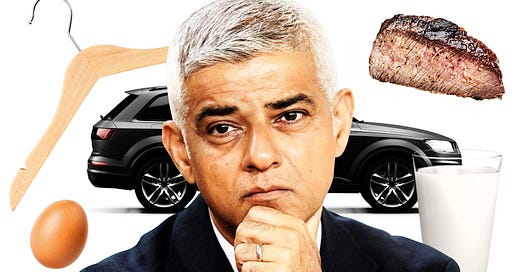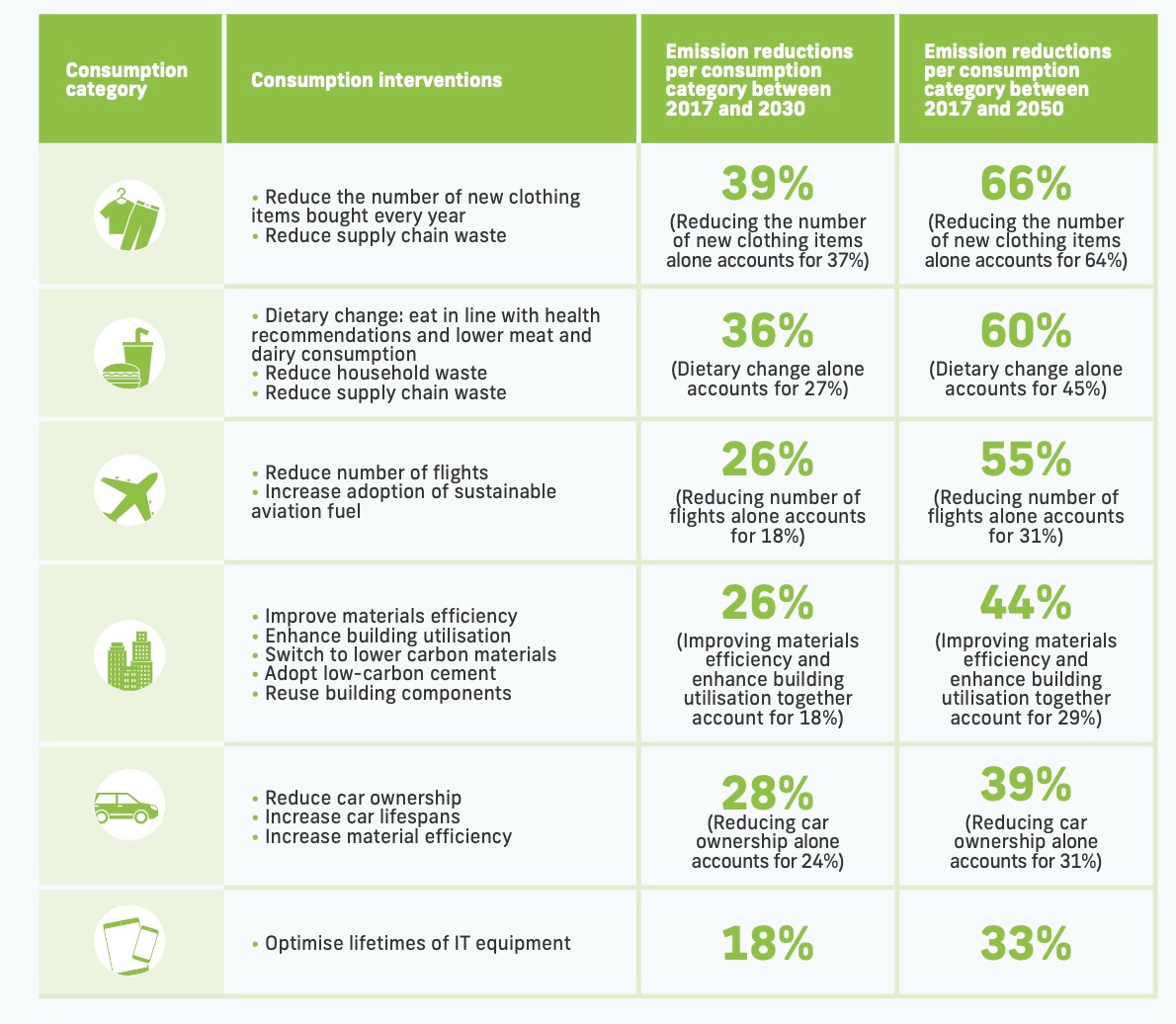Nobody is telling you that you have to give up your hamburger or stop buying pants
But unfortunately, we should; our cities are responsible for vast carbon emissions, much of them from our consumption.
The Daily Telegraph is a terrible British newspaper that makes Canada’s National Post seem fair and balanced. It recently did a hit piece on London’s Mayor Sadiq Khan that starts with a vision of the future:
“Picture the scene. You have just made it through the door from work, although not by car because private vehicles no longer exist. You change out of your work clothes into something more comfortable, perhaps one of three new items of clothing you are allowed to buy every year.
Then it is downstairs for dinner, since all this virtue is hungry work. But don’t forget that meat and dairy are off the menu, so instead you might like to daydream about getting away from it all – only to remember that you used up your quota of one short-haul return flight every three years last summer.
This is the radical vision of a net zero future dreamed up by C40, a global collective of city mayors chaired by Sadiq Khan, which advocates extreme measures to halve greenhouse gas emissions by 2030 and limit global temperature increases to 1.5C.”
That sounds awful! What is this vision, and where are these C40 cities? They are all over, from Toronto to Portland to Miami to London. “Around the world, C40 mayors and the cities they lead are taking ambitious, collaborative and urgent climate action that aligns with science-backed targets.”
The “radical vision” is laid out in The Future of Urban Consumption in a 1.5°C World report prepared by Arup and the University of Leeds in June 2019 and has been picked up now by the Telegraph for no discernible reason. But it is a vision that is worth looking at again.
The most important lesson of the report is its emphasis on consumption rather than production. We have read many books like David Owen’s The Green Metropolis that suggest cities like New York are the greenest places to live because the carbon footprint per capita is so low. But if you look at the footprint of what we consume, it is a different picture. The report shows how we have outsourced our emissions:
Take a pair of jeans, for example. Its climate impact includes the GHG emissions that resulted from growing and harvesting the cotton used for the fabric, the CO2e emitted by the factory where it was stitched together, and the emissions from ships, trucks or planes that transported it to the store. Its impact also includes the emissions from heating, cooling or lighting the store the jeans were bought in and the CO2e emitted by the end- consumer washing and drying it over its lifetime.
The report claims 85% of the emissions from goods and services consumed in cities are generated outside of the city. And that's not just from buildings, but also all the things that we consume in that city, from red meat to cars to blue jeans to electronics to leaving on a jet plane. Given the proportion of the world that lives in cities, we are talking about significant carbon emissions. Like the Telegraph, I found some of the report’s recommendations overly prescriptive and sometimes silly. No meat for you! Only buy three articles of clothing per year! Keep your computer for seven years! Only one short- haul flight every three years!
But when you dig in, it all makes sense.
The biggest shocker for me was the distribution of consumption-based emissions for people in cities; while having buildings and infrastructure coming out on top is no surprise, having food come a close second with 13% of all emissions, even bigger than private transportation, was. Being an architect type of a certain age who only wears the same black things over and over, I was shocked at how big clothing and textiles were, bigger than my bête noir, electronics.
Many are convinced that if we are going to keep under 1.5°C, we have to reduce our consumption of everything. The authors did the math and came up with budgets for each of the six categories, for both 2030 and 2050. Some of these do indeed seem a bit pushy. When I wrote about this at Treehugger, I noted:
Many will roll their eyes over all this, questioning whether personal consumption by individuals belongs in a discussion of cities. I can already imagine the comments, taking away our freedom to buy new pants. I have been told more than once that I shouldn't be focusing on individual consumption; it's the big corporations that are causing the problems. But they are making stuff that we consume. It involves all of us.
The report had a significant influence on my book; you can see it in the title and subhead, Living the 1.5 Degree Lifestyle: why individual climate action matters more than ever.
The Mayor of London denies that he is following this agenda.
A spokesperson for the Mayor of London, said: “This report was published well before Sadiq became Chair of C40. The ideas mentioned are not proposals let alone recommendations and the Mayor is certainly not suggesting to anyone that they shouldn’t eat meat, or that they shouldn’t fly.”
C40 Cities says the same thing, sort of walking back the recommendations.
“The report is a generic analysis of emissions not looking at any specific C40 city. It is not a plan for cities to adopt. It’s up to individuals to make their personal lifestyle choices, including what type of food to eat and what type of clothing they prefer.”
But others have picked up on the report’s recommendations and tried to turn them into a movement. And it is not so drab and dire as the Telegraph makes it out to be; The Take the Jump people make it fun and use it as a way to get people involved.
It was co-founded by Tom Bailey, who worked as Head of Research and then Head of the Sustainable Consumption program at C40 Cities, which explains the similarity between the programs. Bailey told me in an interview: "We're not pointing fingers saying you're evil; you are destroying the planet; that approach just alienates people. It is enough to get people to try, just to start, even if you can't be perfect." This is much needed; people don’t know what to do.
"So many citizens around the world want to act, but feel powerless and confused about what they can do. We need a 21st-century movement which gives citizens the clarity and the tools to start experimenting with the future we need. A movement which draws humanity away from the path to collapse, and onto one that leads to a joyful and prosperous future."
Back in the Telegraph (sometimes called the Torygraph) a Conservative Member of Parliament is having none of the C40 Cities agenda.
“I’ve really had enough of this authoritarian, miserabilist approach to net zero. What we need is for technology and innovation to allow people to become more prosperous and greener at the same time; not poorer, colder and hungrier.”
This is the classic choice they offer us: “Don’t turn down the thermostat- we have hydrogen coming”! Taking the JUMP tells us that it is not miserabilist or dire.
“Live for joy, not stuff, this is not about sacrifice, it is about living our lives more fully. Taking the JUMP does not mean we must stop consuming altogether and go back to living in caves. With the shifts, we can still eat lovely food, see plenty of the world in our lifetimes and dress magnificently. Yet we can do so with more time for ourselves and loved ones, more peace of mind.”
Reducing consumption is critical to reducing carbon emissions; I have been writing books and posts saying “use less stuff” for years. I may switch to “less stuff, more joy”
It is all about attitude. The Telegraph thinks that the C-40 prescription is dire and awful, while Tom Bailey and the Take the Jump team show that it doesn’t have to be. Take your pick.










I am watching the sun rise. Pure joy. The magic of the transforming horizon amazes and lifts me ever time despite my having witnessed it many thousands of times over my 60 years spinning around on this rock. I am enjoying a coffee as I do so not an entirely consumption free activity but pretty close. “Less stuff, more joy” is a wonderful philosophy. I have been working to embrace it for several years now. It is not an easy or quick journey to move away from succumbing to the nagging voice telling me that “if only I had (insert latest manufactured need here) my life would be complete”. The forces fighting that shift every step of the way, internal and external, are strong and know well how to push the buttons of my primitive “grab what you can now it may not be there tomorrow “ mind. And, a casual glance around my place would probably have you questioning my commitment to my new guiding principles. I still have a lot of stuff. But look a little closer and you will notice that almost all of it is not my stuff, it is yours. Things that you tossed aside long before their usefulness expired to chase the latest shiner version or substitute. Look even closer and you may start to notice that much of it is stuff that was built to last and that can be repaired and reused, often for generations. Much of it had already served at least one generation before it found its way to me. Look even closer and you will start to see that much of it was chosen because it will help allow me to get to a place where I and those I share this place with will need to consume less in the future. I make no claim to the moral high ground. I have a lot of making up to the world to do before I will have paid my debt to the future but I am trying to be better. The remarkable thing I have found is that with each step I take toward the idea that there is such a thing as enough I find more joy, not less. Less time chasing stuff leaves a lot more time for watching sunrises.
Less Stuff, More Wealth! My dad was not an environmentalist, but he taught me the value of not internalizing the consumerist culture. He was an immigrant who believed in saving, ie he would pay cash for something like a car which loses value the second you buy it. And when I was growing up I realized our consumerist friends and family were not any happier. And now I have the ability to work less buy what I really want have money for an emergency and no consumer debt.